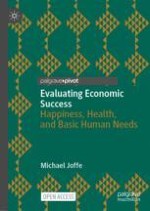Open Access 2024 | Open Access | Buch

Evaluating Economic Success
Happiness, Health, and Basic Human Needs
verfasst von: Michael Joffe
Verlag: Springer Nature Switzerland
Buchreihe : Wellbeing in Politics and Policy
Open Access 2024 | Open Access | Buch

verfasst von: Michael Joffe
Verlag: Springer Nature Switzerland
Buchreihe : Wellbeing in Politics and Policy
This open access book argues that a new policy approach is required in order to tackle the numerous problems the world is currently facing. The priority should be on achieving better outcomes for people, especially those facing deprivation or precariousness, by meeting their basic needs. In order to achieve this, the book develops a monitoring system that can act as an objective, an incentive, and a criterion of success for policy makers at all levels of government and in civil society, as well as providing information to guide specific actions. In doing so, the book aims to promote good health and positive social functioning by providing a new approach to help assess how well basic human needs are being met. This involves monitoring the outcomes of the economy that ought to satisfy these needs. It will appeal to all those interested in public policy, official statistics and monitoring, public health and wellbeing, as well as practitioners.